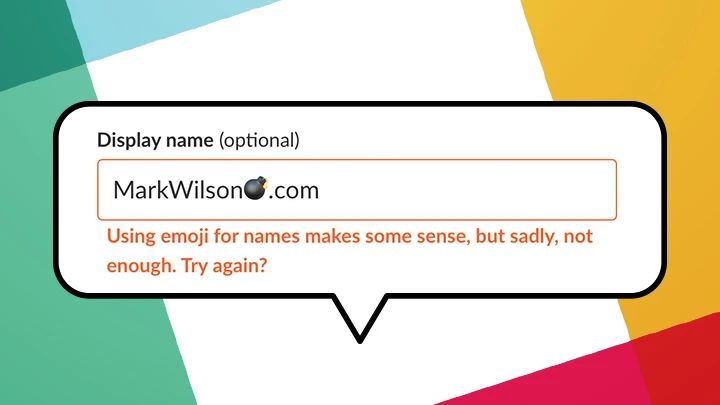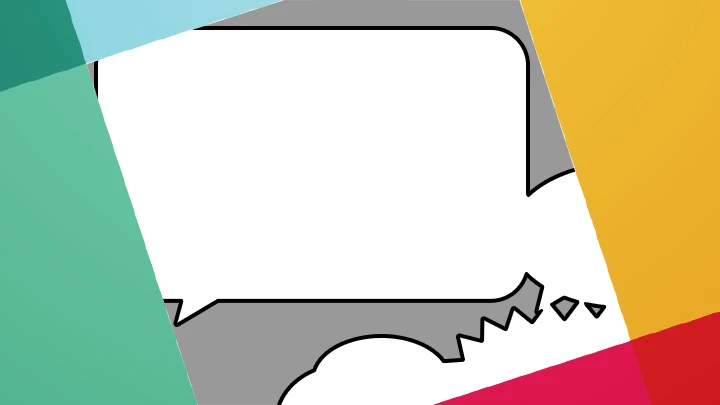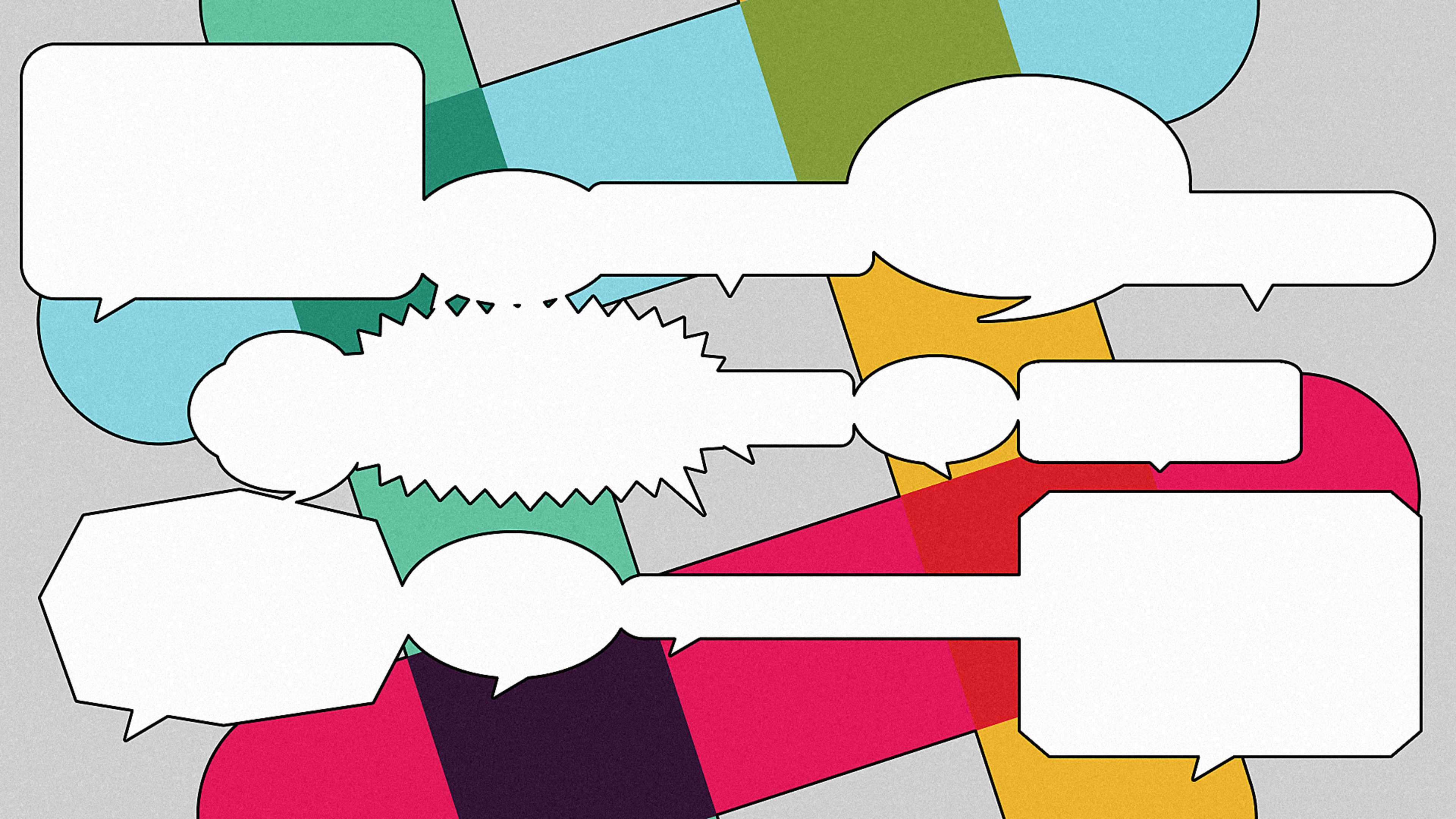It was a magical day at the office. And by the office, I mean Slack, the $5 billion company that brought work into an online chatroom. The entire Fast Company staff learned almost at once that they could fill their user names with all manner of emoji by altering their profile in the smartphone app.
After one person pulled off the feat, the entire edit staff embraced crazy clown faces, sunglasses, and mixed drinks within the hour. I was the emoji Mark Wilson bomb dot com, which quickly transformed into my Slack identity. This seemingly dumb little feature was important to me and my colleagues–a lighthearted reprieve from the grind.
Then, two weeks ago, I went into my Slack profile to update my avatar. When attempting to save the change, Slack told me that “For all manner of complex reasons, names simply cannot contain emoji. Try again?”

It was as if someone walked up and looked me right in the eye while stealing my stapler. The coy copywriting only added insult to injury. Each time I tried to save my name in disbelief, Slack fired off a new cheeky response.

“Of course you want a name with an emoji. Sadly, it is not to be. Try letters?”

“Using emoji in names makes some sense, but sadly, not enough. Try again?”
Slack helped pioneer the breezy tone of Silicon Valley that we now find all over the place, from healthcare sites to millennial retailers. But as the company scales, its impact on work life grows. Slack now boasts 8 million daily active users around the globe, which is roughly four times the headcount you’ll find inside the worldwide reach of Walmart or McDonald’s. And as Slack widens its reach, that casual tone feels less fun and more oppressive.
The rationale behind Slack’s tone
I wrote Slack about this. The company connected me to Anna Pickard, Slack’s witty and widely celebrated head of brand. Pickard’s background is in theater, which she rolled into writing for video games and mega ad agencies like Wieden + Kennedy. Four years ago, she landed at Slack while the company was still figuring out its voice and name, and has since become the ghost in the machine, drafting the company’s style guide and leading a team of writers to create new content.
“The reason that we have a, not informal, but more conversation tone . . . is because what we’re trying to do is encourage people to inhabit that tone, to feel easier talking to each other,” says Pickard. “Everything they encounter should make for natural conservation, and Slack feels like where they can have that conversation.”
Pickard points out that the “knowledge worker,” or what we call guys like me and probably you who work on our computers all day, is a relatively new phenomenon. And coordinating such workers across the globe into group chat is new, too.
“It’s about working with people in their communication style, and allowing them to bring the ease of communication of messaging in their social life . . . into working channels,” says Pickard. “You work in Slack . . . that’s not the same for everyone who works in the world. We’re trying to help [all] people get into the mode of messaging, talking like they do in everyday life. For a lot of people, it’s a leap.”

In this regard, the cheeky tone of Slack is meant as a model and an ice breaker for a method of communication that can feel stuffy or limiting in a corporate context. Slack jokes around so we joke around. And, sure, it works sometimes. But Slack is growing and introducing more features–and as it grows, it can sometimes be difficult to square the casual tone with business realities.
Case in point: For my lost bomb dot com alias, Pickard alludes to technical challenges for the team in internationalizing emoji names. For reasons that still aren’t entirely clear to me, the team removed emoji names at the same time it introduced “away” status customization, which can include emoji, so it seemed like an okay trade. “It’s just not in your name anymore,” says Pickard. “But there are plenty of other spaces for self expression or being your whole wonderful self at work.”
My bigger problem was the tone of Slack’s response. Pickard acknowledges the gaff, saying, “it’s hard to find that balance sometimes.” If this had been a moment where my password didn’t work, she explains, Slack would have used plainer language. But this was a unique case, she insists. It was a moment that I was trying to be clever, and Slack was trying to be clever back. “People are always looking for how they can push the boundaries of the tools they use to see what happens,” she says. “So how do we find those moments when people are at play?” And more importantly, how does Slack acknowledge the behavior while also shutting it down?
One instance where Pickard believes playful rejection works is in group chat, when someone stacks dozens of emoji into something they say. “That is somewhere you also get a message in tone like, ‘We feel like you’re overreacting,'” Pickard says. “Those are moments where we feel like people are in a mode of play, and that might be a point at which we can say, ‘We see you, we appreciate your humor. You’re trying. It’s something that’s not going to work this time, but we get it. So like adding emoji in your name . . . that’s the kind of behavior we kind of want to reward,” she says.
The language of empowerment
But of course, the best way to reward a behavior would just be to enable it, much like the best way to empower an employee is to trust them with some power. In this sense, we can see the tension Slack must face as it continues to grow. Slack might talk like your friend, and it has excelled at persuading users that work is fun. But the reality of being an enterprise software company is making that friendly illusion hard to maintain, whether through setting emoji limits to keep conversations civil or making your private conversations available to your boss on a whim.
Perhaps it would feel more earnest if Slack spoke in a more managerial tone–not joking around, but offering clear, concise edicts as necessary. (After all, it’s through a company named “Slack” that we’ve all become readily available on nights and weekends with automatic push notifications.) When I ask Pickard if Slack’s voice should change as Slack scales, she insists that the external voice of Slack is a reflection of the internal culture of Slack. Slack might tweak the tone now and again, as they do for Twitter and other channels, but the core voice would go unchanged.
This approach may be authentic to Slack, but it also makes a big assumption. It suggests that Silicon Valley’s “Work is fun! But make sure you work!” cool voice, cool culture, feels authentic everywhere else, too–an assumption that is, increasingly, out of touch. Slack taking away my silly emoji name wasn’t a big deal, but its tone deafness proved something else: Slack might not understand work culture in 2018 so well, after all.
Recognize your brand’s excellence by applying to this year’s Brands That Matter Awards before the early-rate deadline, May 3.
